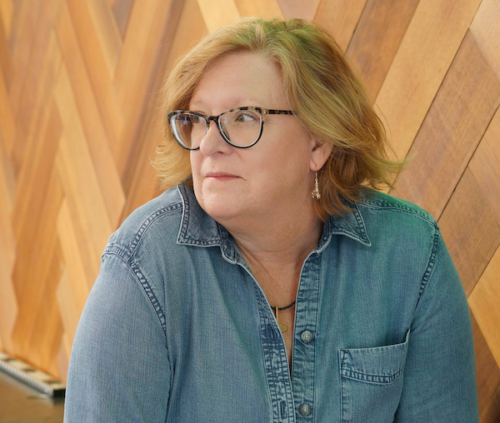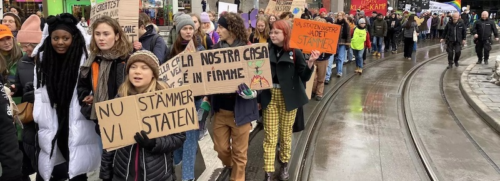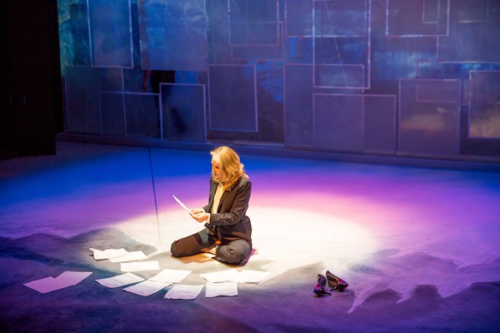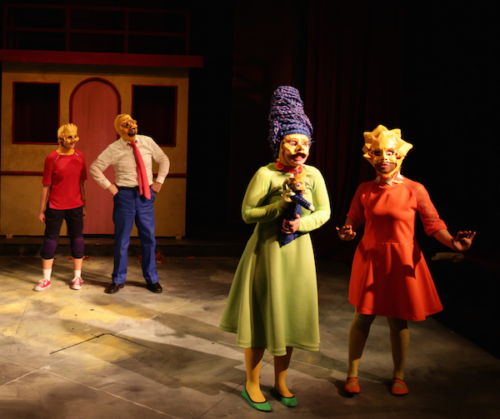Do we feel the environment breakdown in our gut? Will people looking back see art that conveyed the existential threat of the emergency?

Back in 2005, author and environment activist Bill McKibben wrote a piece called “What the Warming World Needs Now is Art, Sweet Art” in which he wondered why the climate crisis had “yet to register in our gut,” that it hadn’t become part of our culture: “Where are the books? The poems? The plays? The goddamn operas? Compare it to, say, the horror of AIDS in the last two decades, which has produced a staggering outpouring of art that, in turn, has had a real political effect. I mean, when people someday look back at our moment, the single most significant item will doubtless be the sudden spiking of temperature. But they’ll have a hell of a time figuring out what it meant to us.”
Nearly two decades have passed, and our culture has changed. Far more books, poems, plays, and even “goddamn operas” inspired by the climate crisis have been produced. But do we feel the environment breakdown in our gut? Will people looking back see art that conveyed the existential threat of the emergency? Have artists dealing with the climate meltdown had any “real” political effect? I would argue that our art has not delivered a gut punch and that contemporary American theater has pretty much been missing in action. And that is symptomatic of our dangerous embrace of denial — or is that innocent trust? — that those who got us into this mess are going to get us out, without our pushing them with all of our might to do the right thing. “Perhaps the way we respond to the crisis is part of the crisis,” observed Bayo Akomolafe. Producers can’t decide how climate change should be presented to theatergoers: they fear that scripts that come on too strong will scare off well-heeled audiences. Preaching is frowned upon. The scripts I have read tend to separate into three categories: warnings that inaction contributes to the coming catastrophe, dramatizations of people seeking solutions, and utopian scenarios that posit an optimistic vision to work toward, including eco-socialism and ecodharma.
These theatrical approaches have their strengths and weaknesses. Scripts that combine elements from each might be the most effective. But theaters have up until now generally ignored the forces that need to be placed center stage — politics, class, and spirituality. Of course, stage companies, for the sake of maintaining “business as usual,” neglect these hot-button targets. But those who are pumping out hothouse gases — and their enablers — must be confronted. The fossil fuel industry is not the only culprit, but its collaborators, including megabanks and governments, through greed and arrogance are killing the planet. It is time to name names. In the American Repertory Theater’s Ocean Filibuster, for example, the polluted oceans were given (intentionally?) bad legal advice: they should have been suing oil and gas companies, wealthy countries, oligarchs, megabanks, and dictators, not “Mr. Majority.” The future will call for stories that strengthen our primal interconnection with nature, tales inspired by the biophiliac perspectives of Indigenous people: “Before, nature had a life and spirit of its own. The trees, skies, and rivers were living spirits. Now we are only concerned with how they can serve us.” — Phra Paisal Wisalo. Finally, stage companies should be challenged: how can they help create the kind of broad collective — across the classes — that will be needed if we are going to force the necessary changes? Dealing with the crisis will call for well-led and well-organized groups of people, millions (eventually) who will demand that we slow and then reverse our mad dash toward extinction. Theaters could be one of the institutions that inspire that broad alignment, strengthening the resolve of what might become an army of dissenters from the neoliberal status quo.
A partial model for this partnership would be ’60s protest theater, which drew on the era’s spirit of civil disobedience. Companies such as Bread and Puppet Theater, the San Francisco Mime Troupe, and The Living Theatre were spawned by — and at times coordinated with — the era’s protest movements. They staged entertaining but pointed works that raged against the Vietnam war and capitalism, that condemned race and gender discrimination. What’s missing today is that crucial link between the stage and real-life efforts to demand justice and confront authority. I suspect it is because our highly commercialized, Broadway-crazed companies are genuflecting to economic interests. Outside of this hermetically sealed Neverland, however, protests — in the streets, at private airports, and in the lobbies of banks condemning fossil fuel companies and their investors — are growing in number and fervency. And these could be used to inspire drama that explores acts of rebellion and repression, such as 2016’s generation-defining struggle against the Dakota Access Pipeline or the growing number of lawsuits being brought against countries because of their grievous inaction.

More outrage is sure to come as environmental disintegration continues without the requisite global responses. As public anger mounts, I am confident our “concerned” stage companies will find it difficult to remain so comfortably disengaged. Lip service will wear thin as the earth warms and the oceans further acidify. The sooner this indifference — driven by short-term concerns and fealty to head-in-the-sand conventionality — ends, the better. People in the future will look back at the passivity of our stage artists with justifiable disgust. Why were they so timid as the earth tipped into environmental free fall?
In that spirit, I wanted to talk to a dramatist who has written theater pieces on the climate emergency. Tira Palmquist has penned one play about the crisis, Two Degrees, which has been produced professionally. She is currently writing another script about the warming planet. I asked her about why so few dramas are being produced about the crisis, greenwashing in the arts, and what she thought about the chances for the appearance of activist theater.
[Note: A staged reading of Two Degrees, co-presented by Central Square Theater and Catalyst Collaborative@MIT (as part of their Science on Stage reading series), will take place at the MIT Museum, 314 Main Street, Cambridge, on December 5 at 6:30 p.m. 6 p.m. cash bar and refreshments. The performance will be followed by a conversation with a guest scientist.]
The Arts Fuse: Researchers at HowlRound have noticed the low engagement with the topic of climate breakdown by theater practitioners and members of the industry around the country. Why do you think that is, given the enormity of the emergency?
Tira Palmquist: I think the level of engagement is connected to how overwhelming we perceive the problem to be. But also, I think many people think — and who could blame them — that there’s a kind of inevitability to the issue. No matter how we tell the story, the story is, “And we all die in the end.” And who wants to go to plays where that’s the inevitable, predictable outcome? Basically, what an effing downer, and let’s go see a comedy instead.
I think that people don’t want to be yelled at, nor do I think that yelling at people changes their minds. That’s not to say that yelling isn’t appropriate, given the size and scope and terror of the problem. But I wonder if this has something to do with the power of boards regarding programming. That is to say, that the issue of engagement and what plays get programmed have less to do with what the audience wants, or will tolerate, and more to do with what sells, or what is perceived to be sellable. That’s unfortunate, but true.
AF: You have written a play about the climate emergency and plan to do another. What are the challenges of writing scripts about climate change?
Palmquist: The first challenge has to do with your first question. Are there other stories instead of the tragic story we think we all know?
The second challenge is being more precise about what we mean when we say “I’m writing a play about climate change.” That topic is so broad, so unwieldy. Sort of like saying, “I’m writing a play about history!” So, like any writing challenge, it comes down to clarifying what the story is. Whose story is this? What do they want? What’s the conflict? What’s the obstacle, standing in the way of the fulfillment of their desires?

With Two Degrees, for example, I knew I wanted to write a play about a woman, a scientist. I knew I wanted to write a play about grief. But I also knew it wasn’t just? a story about grief. It was, essentially, a play about how we have to figure out what to do? with all that grief, how to figure out how to communicate. Recently, someone told me about something that Anthony Fauci (apparently) said: Science + politics = politics. And if that formula is true, then what can science do not to get erased? That’s essentially Emma’s journey in the play: to find a way forward, fueled by fury.
The third challenge in writing a play about the climate is to do the research, to understand the science, to get all that right. I think it’s an absolute necessity to learn the science and communicate that science — clearly and effectively. Because, ultimately, I think knowledge is? power — and we have to trust our audiences enough not to dumb that down.
AF: What role, if any, should local institutions play in helping theaters deal with climate breakdown, in terms of making facilities and organizational practices greener? What might educational institutions, banks, and philanthropies think about doing?
Palmquist: That’s an excellent question that I’m not sure I can answer completely — but one thing that can help making theaters greener is to have shared resources — such as clearinghouses of sets, costumes, set pieces, and the like. I also think that there’s a lot we can do to encourage the use of local resources and hiring local talent. I recognize that these may seem overly simplistic — but not having to fly in artists from around the country when communities may already have those artists available can certainly help.
I think this is related to what institutions and philanthropies can support in terms of these more sustainable practices. I mean, these are interconnected systems — and funders or backers might need help in seeing the value in funding more local initiatives.
AF: Address the thorny issue of theater and greenwashing. How can we distinguish between radical approaches that meet the demand of frontline communities and efforts that are simply about commercial lip-service?
Palmquist: I hope I know exactly what you mean in this question. I think you mean — is it enough to have QR codes and not print programs? No. After all, making your patrons use their electronic devices rather than providing a paper program is still a use of resources. (And if you don’t have free WiFi, then, please, don’t do this.) Is it enough to have recycling in the lobby? Probably not, especially if you still have plastic cups and plastic bottles. So a more radical approach to hospitality or front-of-house aspects of audience hosting might be necessary. But this probably requires hiring more front-of-house staff, and that’s another? thing that some theaters don’t have the budget to cover. So, funders take note: not all staffing issues are artistic staff, and these staffing requirements are just as important as hiring artists.
There are many other issues about more sustainable practices that are complicated by the realities of small theaters’ budgets. For example: Productions require electrical power to run lights. How many theatrical spaces have solar panels or battery systems? Probably not a lot. This is partially because — again — that’s just not in the budget, and I’ve seen grants that will pay for everything except? capital campaigns or brick-and-mortar upgrades to a venue. That’s one place where institutions or philanthropies could help arts organizations to operate more sustainably, and make a measurable difference in the long-term carbon footprint of the performing arts.
AF: What are some of the strongest scripts (or art work) that you have come across — and why are they effective?
Palmquist: Well, of course, I’m mighty fond of my own scripts.
I’m drawn to stories or art work that make the questions (and potential answers) immediate, visceral, possible. For example, the visual/installation artist Olafur Eliasson does astounding things with ice and temperature and space — making the audience confront the changing world.

Two of my favorite plays that I think of as climate change plays (or, at least, plays about our future world) are The Children by Lucy Kirkwood and Mr. Burns by Anne Washburn. These are successful because they demonstrate the alarming capacity for humans to fail to deal appropriately or effectively with devastating change — and they put our human responses in the center of the play. I also love these plays because they don’t offer overreductive questions or oversimplified answers. They are complicated, unsettling stories about what it means to make sense of difficult moments, that challenge our role in the world, or our role in how it fails or thrives.
AF: In a HowlRound essay, Thomas Peterson argues that “the climate crisis demands new, locally specific plays to respond to the unique challenges of the place in which they are created and performed. After all, climate change impacts different places in different ways and at different times, challenging the very possibility of universal climate stories.” Do you agree?
Palmquist: Absolutely. This is one reason why I started my new play Memory of Winter. This play is set, primarily, on or near Lake Superior. People think about Northern Minnesota as somehow beyond the effects of climate change, as a “climate refuge.” But of course that’s not true. While Duluth might not see the same climate effects of, say, Las Vegas or San Diego, changes are happening there. And this may be part and parcel of why people don’t perceive the real and profound threat of the climate emergency. If we think of climate change as only one thing (melting ice caps, for example), and we don’t see that one thing anywhere near us, then it’s easy to dismiss the emergency altogether. As humans, we’re very good at minimizing changes as they happen slowly, over time. You know: frogs in pots, unable to see the threat gradually cooking us.
I also think something that we don’t talk about enough is how climate change impacts different communities inequitably. Someone might ask, how can climate change be racist? How can climate change be classist? Racism and classism is baked into the system, into the design of our cities, in the inequitable response after disasters. This is one reason why I think the art and the plays should come from the very communities that are under the greatest threat from the kinds of impacts we’re seeing in this changing world. Their stories matter, and should be in front of us.

AF: Why aren’t theater practitioners and members of the industry more politically engaged regarding the climate breakdown? Agit-prop theater has traditionally been involved in protests. In this case, one of the targets would be the power of the fossil fuel giants.
Palmquist: I suppose the real question is what it means to be politically engaged, and what political engagement looks like. Agit-prop has, to some extent, gone out of style, though the need for agit-prop has not vanished. But ultimately, I don’t think agit-prop is the only game in town. It’s like … the activists throwing soup on paintings. These are headline-catching events, and certainly that has some appeal — but what impact do these events have, past the headlines? I’m not sure.
I think it’s a genuinely useful question, though, to ask what it means to be politically engaged, and what it means to engage with the public. I’d like to broaden our definition of what “political theater” is. If the ultimate goal is to have these kinds of profound and lasting conversations with the public, then we need to have theater that matters to people, stories that matter, stories in which our audience can see themselves, and can see their role in all this.
Article by Bill Marx for Arts Fuse.